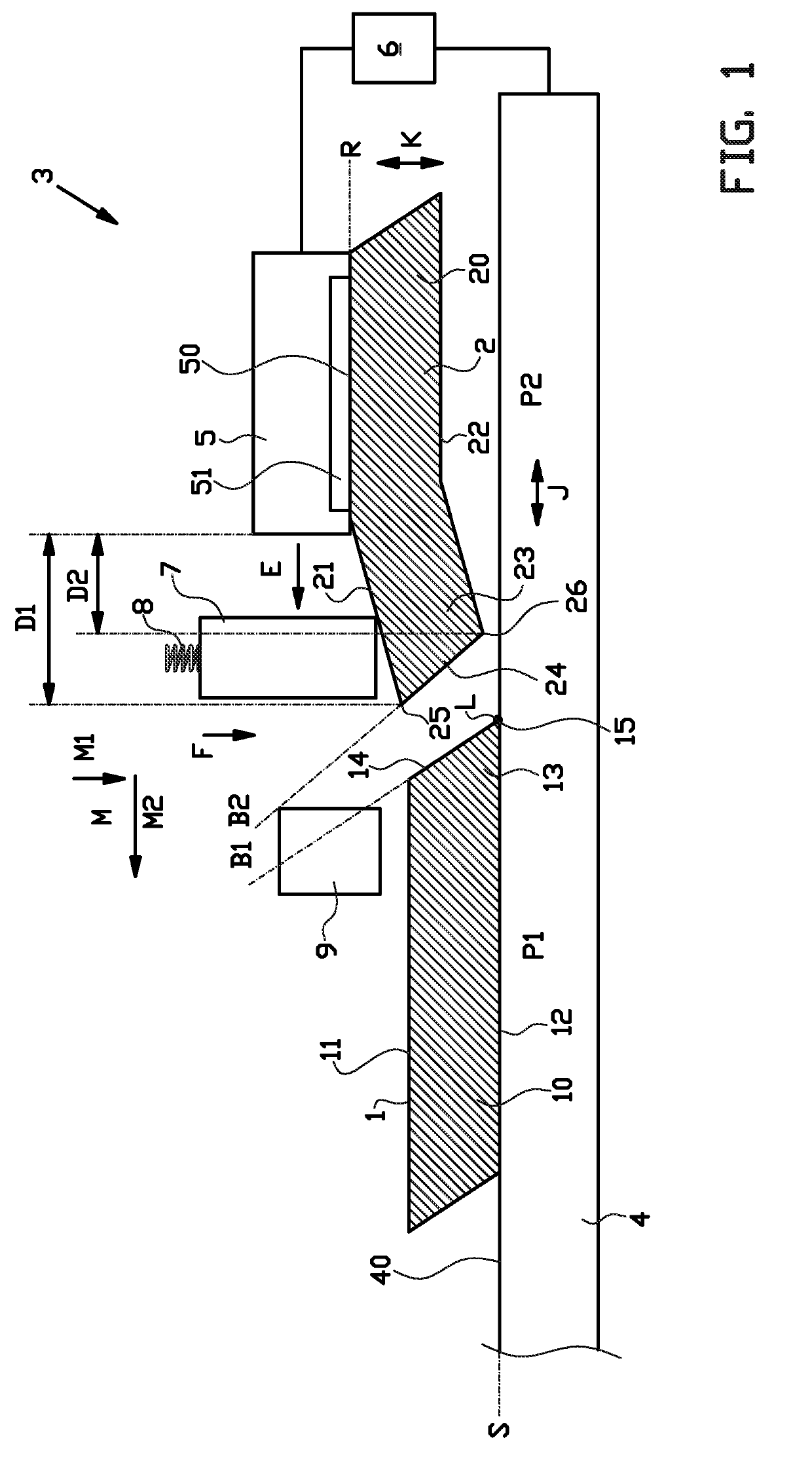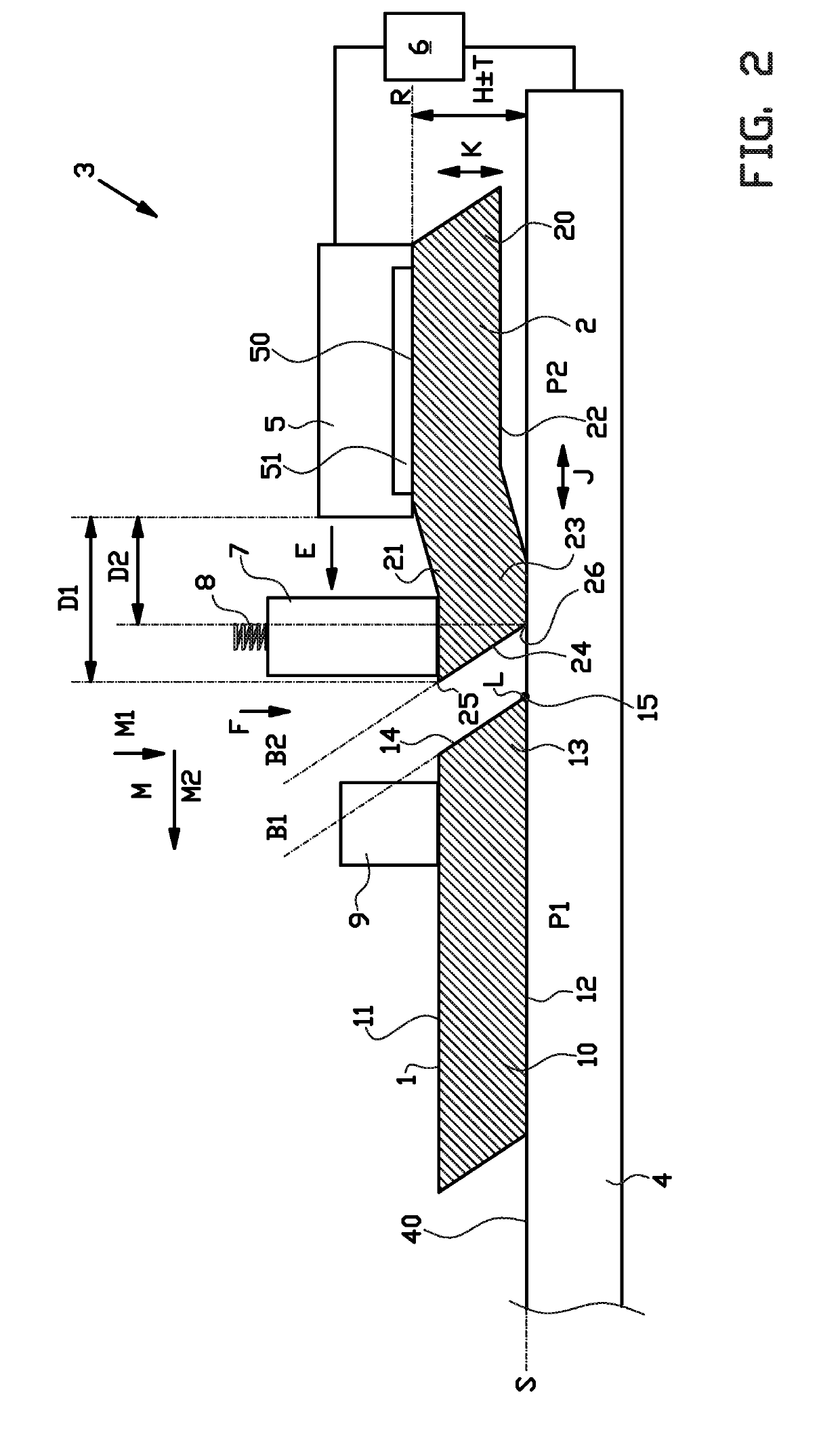Joining device and method for joining strips to form a tire component
a technology which is applied in the field of joining device and tire component for joining strip to form tire component, can solve the problems of inability to tolerate the accumulation of tolerance between the discharge conveyor and the gripper that retains the second strip, deformation of subsequent tire layers, and inability to meet the requirements of the application
- Summary
- Abstract
- Description
- Claims
- Application Information
AI Technical Summary
Benefits of technology
Problems solved by technology
Method used
Image
Examples
first embodiment
[0046]FIGS. 1-4 show a joining device 3 according to the invention during the steps of a method according to the invention for joining, pressing or splicing a first strip 1 to a second strip 2 to form a tire component.
[0047]The tire component is preferably a breaker ply or a body ply for building a green or unvulcanized tire. The first strip 1 comprises a strip body 10 with a top surface 11, a bottom surface 12, a trailing end 13 and a bevel end surface 14 that meets with the bottom surface 12 at a first bevel angle B1 to form a trailing edge 15. The second strip 2 comprises a strip body 20, a top surface 21, a bottom surface 22, a leading end 23 and a bevel end surface 24 that meets with the top surface 21 and the bottom surface 22 at a second bevel angle B2 to form a leading edge 25 and a recessed edge 26 respectively. The bevel angles B1, B2 of the respective strips 1, 2 are the same or substantially the same. The strip bodies 10, 20 are typically manufactured from unvulcanized, ...
second embodiment
[0065]FIGS. 5 and 6 show an alternative joining device 103 according to the invention. The alternative joining device 103 differs from the previously discussed joining device 3 in that the deflection member 107 is actively controlled. More in particular, the alternative joining device 103 comprises an alternative deflection actuator 108 that is operationally coupled to the deflection member 107 for actively driving the movement of the deflection member 107 in the deflection direction F between the flush position of FIG. 5 and the deflection position of FIG. 6.
third embodiment
[0066]FIGS. 8-11 show a further alternative joining device 203 according to the invention. The further alternative joining device 203 differs from the previously discussed joining devices 1, 103 in that it comprises an alternative retaining member 205 without a deflection member. Instead, the leading end 23 of the second strip 2 is allowed to freely project from the alternative retaining member 205 over the first projecting distance D1 in the projecting direction E. The alternative retaining member 205 is positionable in a joining position, as shown in FIG. 8, in which the retaining plane R extends above the second strip position P2 and declines or descends towards the joining line L under an oblique joining angle A with respect to the support plane S. The joining angle A is slightly exaggerated in the drawings to clearly demonstrate the invention. In practice, the joining angle A is preferably in a range of two to six degrees, preferably two to five degrees, most preferably three t...
PUM
| Property | Measurement | Unit |
|---|---|---|
| joining angle | aaaaa | aaaaa |
| joining angle | aaaaa | aaaaa |
| joining angle | aaaaa | aaaaa |
Abstract
Description
Claims
Application Information
 Login to View More
Login to View More - R&D
- Intellectual Property
- Life Sciences
- Materials
- Tech Scout
- Unparalleled Data Quality
- Higher Quality Content
- 60% Fewer Hallucinations
Browse by: Latest US Patents, China's latest patents, Technical Efficacy Thesaurus, Application Domain, Technology Topic, Popular Technical Reports.
© 2025 PatSnap. All rights reserved.Legal|Privacy policy|Modern Slavery Act Transparency Statement|Sitemap|About US| Contact US: help@patsnap.com



